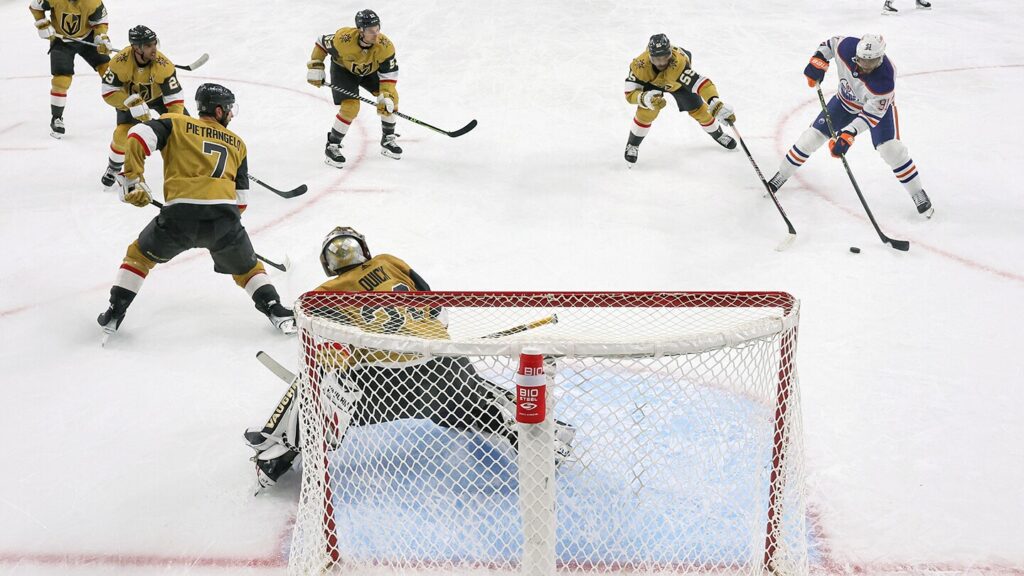In an age of superlatives, one might find it surprising that the undulating landscape of the NHL has crystallized at an average player height of 6 feet 1.09 inches (185.67 centimeters). In the bustling arenas of the 2024 NHL season, this precise measurement presents not just a numeral but a story of athleticism that threads through the ice, representing a stature that stands about an inch below NFL giants and nearly vaults over the benchmark of the average American male.
It’s this unique measurement’s interplay with the agile, fast-paced world of hockey that offers valuable insights into the game’s current climate. With official data straight from NHL.com and over 1,500 active players considered, the NHL player heights eloquently reflect how Hockey player heights in 2024 underscore the diverse physicality of the league’s talent.
With goalies averaging at a towering 6 feet 2.69 inches (189.7091 centimeters), defensemen at a formidable 6 feet 1.54 inches (186.804 centimeters), and forwards skating in at a swift 6 feet 0.54 inches (184.24 centimeters), the NHL reveals a subtly stratified realm of athletes.
Here height is but one indicator of success, as showcased by the feats of goaltenders like Juuse Saros who, standing at 5’11”, skates under the average yet has achieved a remarkable number of shutouts.
This speaks volumes about the league where skill, heart, and strategy intermingle with physical stats like the Average Height of NHL Players in 2024 (By Position) to create the thrilling spectacle that is NHL hockey.
Key Takeaways

Source: novacapsfans.com
- The NHL has reached an average player height of 6 feet 1.09 inches in the 2024 season, offering a fresh perspective on the athleticism that defines the league.
- Distinguishing between positions, the roles of goalies, defensemen, and forwards showcase diverse average heights, with goalies standing tallest.
- Despite an overall towering average, the NHL celebrates athletes like Juuse Saros who excel beyond their height, exemplifying that skill can transcend physical measures.
- Official NHL.com statistics provide a robust gauge on Hockey player heights 2024, painting an accurate picture of the league’s physical landscape.
- Understanding these measurements aids viewers and teams alike in appreciating the multifaceted nature of player attributes in professional hockey.
The Significance of Player Height in NHL Positions
In the fast-paced world of the NHL, the physical attributes of players often serve as a source of significant interest and strategic consideration. Understanding the average height by NHL position provides an intriguing glance into the league’s athletic demands and the versatility required to excel in professional hockey.
Comparing NHL Player Heights to Other Sports
When juxtaposed with athletes from other major professional sports leagues, NHL players present a unique athletic profile. While looking at the NHL forward height average reveals a stature slightly shorter than the giants of the NFL, it is still markedly towering when compared to the U.S. male average, delineating the sport’s unique physical ethos.
Height’s Impact on Performance by Position
With position-specific responsibilities dictating the game’s flow, the average height by NHL position can often shape a player’s efficacy. Goalies such as Juuse Saros, who stand shorter than the NHL average and yet shine in their roles, exemplify the vital blend of skill and stature.
Similarly, NHL defenseman height statistics emphasize the dual advantage of having towering players who can impose a significant presence on the ice.
Debunking Myths: Size vs. Skill in Hockey
Despite prevalent myths that suggest that larger size equates to better performance, the NHL storyline champions players of all statures. Standouts across all positions, from the noteworthy 6’9″ Curtis Douglas to the impressive 5’7″ Cole Caufield, continue to prove that a player’s success is not solely determined by their physical dimensions but also by their heart and skill.
| Position | Average Height |
|---|---|
| Forwards | 6 feet 0.54 inches (184.24 cm) |
| Defensemen | 6 feet 1.54 inches (186.804 cm) |
| Goalies | 6 feet 2.69 inches (189.7091 cm) |
These figures serve as a baseline, highlighting not only the overall landscape of player sizes but also the exceptional performances that transcend these averages. In the NHL, the ultimate translation of skill onto the ice shows that the league values capability over mere physical stature.
How Player Heights Contribute to NHL Team Dynamics
Within the competitive landscape of the NHL, player heights can influence team strategies and performance. A team’s lineup often reflects a strategic balance, drawing on the unique strengths of its tallest and shortest players—a concept encapsulated by the New York Rangers’ considerable height diversity.
Understanding height’s role within NHL teams is crucial for grasping the comprehensive nature of the sport’s strategic development.
The tallest NHL players in 2024, towering with commanding presence on ice, offer distinct advantages in reach and physical matchups, often becoming cornerstones in defensive positions or providing an edge during face-offs.
Conversely, the shortest NHL players by position often excel in speed and agility, exploiting smaller gaps and demonstrating that stature does not confine skill or contribution to team success.
| Position | Advantages of Taller Players | Advantages of Shorter Players |
|---|---|---|
| Forwards | Extended reach, advantageous in puck battles | Lower center of gravity, aiding in maneuverability |
| Defensemen | Elevated puck clearance capabilities | Quicker transitions and agility |
| Goalies | Wider coverage of the goal area | Faster reflexive movements |
Teams in the NHL leverage these intrinsic physical attributes to their advantage. By fielding players that embody the extremities of height within their rosters, teams manifest a diversity that not only enriches the sport but also underscores a dynamic approach to formulating winning strategies.
Historical Perspective of NHL Player Heights and Trends
As the NHL surges forward into 2024, a reflection on the historical NHL player height trends not only enlightens fans but also reveals the strategic evolution within the sport.
From the first recorded statistics to the current measurements, player heights have steadily climbed, pencil-marking a trend that is as much about physicality as it is about the changing dynamics of hockey itself. The jigsaw of these trends fits into the bigger picture of how the evolution of hockey player heights in 2024 has altered the very silhouette of the modern player.
Tracing the Growth Trends in NHL Player Sizes
Scanning the historical tapestry of the league unveils that from the late 1960s to the cusp of the millennium, players grew, on average, by over two inches.
However, calling upon contemporary data, the energizing speed of player height increase has calmed. In the past two decades, the increase is a modest 0.35 inches, a whisper compared to the thunderous growth of past years.
This toning down of the increase signals a stabilization of player height as the league inches towards a physical equilibrium.
Changes in the NHL Post “Clutch & Grab Era”

Source: pinterest.com
Unpacking the post-lockout epoch, the NHL’s departure from the ‘Clutch & Grab Era’ is as much a discussion about player weight as it is about height. A paring down of player weight accompanies not just an echo of change but rather bellows a full-throated announcement that the game has pivoted towards velocity and finesse.
This exponent of the game’s transformation is inked onto the very roster sheets of teams who now sport leaner, yet no less effective, gladiators.
Evolution of the Sport and Its Impact on Player Builds
The architecture of hockey players has been quietly responsive to the reverberations of the game’s evolution, where the intrepid combination of agility, speed, and skill carves itself into the template of the modern player’s profile.
This sculpting has not been immune to the prevailing winds of change that have swept across the rinks, crafting a new breed of athletes whose builds represent the “Evolution of Hockey player heights 2024” – balanced, dynamic, and befitting the contemporary narrative of the NHL.
Goalies: Guardians of the Net and Their Stature
The 2024 NHL season has seen a continued emphasis on the importance of a goalie’s physical presence between the pipes. With NHL goalie height statistics revealing an average height of an NHL goalie at an imposing 6 feet 2.69 inches, teams prioritize a considerable stature in their last line of defense. However, as the game advances, it is not just about size but also agility and skill.
In-Depth Analysis of Goalie Height Average in 2024
Analyzing the average height of an NHL goalie offers insights into current team preferences for goaltending. These athletes’ reach and wingspan can cover substantial areas of the goal, thereby reducing the angles available to opposing shooters.
Nonetheless, netminders like Juuse Saros contrast against the towering figures, demonstrating that height is but one factor in goaltending excellence.
Famous Short and Tall Goalies and Their Achievements
Famous NHL goalies by height range from the shorter elites like Juuse Saros to the sky-scraping Mads Søgaard, without a direct correlation to their on-ice success. While Søgaard’s height creates an intimidating presence, Saros’s agility and quick reflexes epitomize that smaller goalies can also achieve remarkable feats on the ice.
The Role of Height in Goalie Success and Strategy

Source: amazon.science
Height plays a multifaceted role in a goalie’s success and the strategies employed by teams. Taller goalies may have a natural advantage in their ability to cover more of the net, but their success is inherently tied to quickness, positional awareness, and puck tracking ability.
Therefore, while height is a notable statistic, it is the combination of physical and mental attributes that forges an elite goaltender.
Defensemen: The Towering Protectors on Ice
Within the NHL, defensemen serve as formidable backbones to team defense, blending size with skill to safeguard their zone. NHL defenseman height statistics underscore the impact of stature, with players averaging 6 feet 1.54 inches, bringing an inherent advantage in reach and visibility.
Height plays a key role in physical matchups and puck battles along the boards, contributing to the mold of a prototypical defenseman.
Yet, stature tells only part of the story; the league’s agility and puck-handling prowess are equally demonstrated by the shortest defensemen in the NHL, marking a position represented by a diverse height spectrum.
Like the towering peaks of Zdeno Chára, these athletes solidify the defensive lines, making their mark as giants of ice hockey.
Contrariwise, players like Domenick Fensore utilize speed and agility to break conventional stereotypes, proving that exceptional talent and strategic play are vital components of modern defensemen, irrespective of size. The table below highlights some of the tallest and shortest defensemen in the NHL, portraying a position as varied as it is critical.
| Defenseman | Height | Team |
|---|---|---|
| Zdeno Chára | 6’9″ | Washington Capitals |
| Domenick Fensore | 5’7″ | Charlotte Checkers (AHL) |
| Tyler Myers | 6’8″ | Vancouver Canucks |
| Jared Spurgeon | 5’9″ | Minnesota Wild |
The dynamic skill set and physical presence of NHL defensemen contribute enormously to the success of hockey teams, emphasizing that while height may be an attribute, it is certainly not the sole determinant of a defenseman’s capability on the ice.
Forwards: Speed, Agility, and Height Statistics
Among the positions in the National Hockey League, forwards are often recognized for their speed and agility, displaying a mesmerizing mix of athletic prowess. Their height statistics, however, bring another layer of diversity to the rink.
As the 2024 season unfolds, it showcases a range of stature among the NHL forward height average, with a noteworthy representation of both towering players and those notably under six feet.
Height Averages for Centers, Left, and Right Wings
The NHL boasts players who fulfill their roles with finesse, regardless of their vertical measurement. Height averages for NHL centers and wingers reflect a slight variation in their respective positions.
On the center of the ice, players have hit an average height of 73.01 inches, while left wings stand close behind at an average of 72.89 inches. Right wings, maintaining the pattern, come in at a nearly indistinguishable average height of 72.83 inches, indicating how the game values skill over size.
Outliers in Forward Heights and Their Performance Impact
Despite a semblance of homogeneity in average heights, the NHL welcomes outliers. NHL centers like the 6’9″ Curtis Douglas tower over the competition, demonstrating that unique physical attributes can contribute to distinct playing advantages.
Conversely, forwards like the 5’7” Cole Caufield and 5’8” Kailer Yamamoto exemplify that smaller stature does not preclude high performance on the ice, as they remain formidable competitors against taller stature opponents.
Comparing 2024 Forward Height Averages to Past Years
Examining the comparison of NHL player heights over years, data reports minimal fluctuation in the average forward heights. This steadiness underscores a key notion inherent within the sport: the success of NHL forwards owes more to their athletic skill than to their dimensions.
As the league continues to evolve, the players’ heights parallel its history, suggesting a firm endorsement of balanced physical attributes coupled with agility, technical skill, and the motivation to put it all together.
| Position | Average Height (2024) | Average Height (Previous Years) |
|---|---|---|
| Centers | 73.01 inches | 72.90 inches |
| Left Wings | 72.89 inches | 72.85 inches |
| Right Wings | 72.83 inches | 72.88 inches |
The Physique of NHL Players: Height Versus Weight Considerations
An in-depth examination of NHL players’ physiques, factoring in both height and weight, provides a more nuanced understanding of athletic build in the league. Focusing on the average weight of NHL players by position, statistics reveal key differences that go beyond the ice.
For the 2024 season, these data points offer insights into how players’ physical attributes balance with the demands of their roles and illustrate the height versus weight in NHL players.
| Position | Average Weight | Average Height |
|---|---|---|
| Forwards | 198.22 lbs | 73.45 in |
| Centers | 196.90 lbs | 73.01 in |
| Defensemen | 202.84 lbs | 73.92 in |
| Goalies | 204.58 lbs | 74.96 in |
The collective average weight across all NHL players stands at approximately 199.54 pounds, with defensemen tipping the scale as the heaviest on average. Complementing their stature, the average height contributes to their defensive capabilities and presence on the ice.
Meanwhile, centers, although being the lightest, showcase agility that complements their swift gameplay, highlighting the intricate relationship between height versus weight in NHL players.
Average Height of NHL Players in 2024 (By Position)
The latest stats on NHL player height by position provide a fascinating glimpse into the league’s physical landscape for the 2024 season. These statistics are more than just numbers—they represent the evolution and strategic considerations that go into team development and player selection.
Understanding the height dynamics within the NHL allows us to appreciate how teams might tailor their play style and approach to the game. Goalies, the last line of defense, boast the most impressive average height, giving them a perceived advantage in net coverage.
Defensemen follow, with their stature aiding in physical matchups and reach for puck control. Forwards, while slightly shorter on average, bring agility and quickness, crucial attributes for offensive maneuvers.
| Position | Average Height (inches) |
|---|---|
| Goalies | 74.96 |
| Defensemen | 73.92 |
| Forwards | 73.45 |
This detailed enumeration not only serves to satisfy the curiosity of fans but also gives coaches, scouts, and players themselves, critical details that influence the game’s tactics. It highlights the nuanced profiles across different roles and underscores the importance of an optimal mix of player heights in constructing a competitive team.
Within the eclectic tapestry of the NHL roster, each player’s height contributes to the whole. The average NHL player height details shed light on the contemporary standards of a league that continues to celebrate diversity in athletic prowess and potential.
The Tallest and Shortest: Extremes in NHL Player Heights

Source: si.com
The landscape of the National Hockey League demonstrates a vast spectrum of player heights that underscore not only the physical diversity but also the inclusivity that defines the sport.
In 2024, the tallest NHL players, like the formidable 6’8” Tyler Myers and the robust 6’7” Jamie Oleksiak, continue to impress with their sheer presence on the ice, bringing unique advantages to their team’s strategies and fortifying their defensive and offensive maneuvers with their physical stature.
These athletes represent NHL player height extremes, embodying the towering end of the spectrum that has often been seen as advantageous in a sport driven by physical competition.
Spotlight on the Giants: The Tallest NHL Players in 2024
These athletes indeed hold their ground as the stalwart protectors and intimidating presences in their various roles. Their contribution goes beyond playing—acting as a psychological deterrent to the opposition.
The scale of their achievement forces a reconsideration of how we perceive physical attributes in correlation with sporting success, with their height being a focal point of conversation and awe within the league.
The Undersized Underdogs: Shortest NHL Players by Position
Conversely, the league’s respect for diversity in player size is epitomized by the perseverance and success of its shorter athletes. At 5’8″, players such as Nathan Gerbe challenge preconceived notions of an ideal hockey physique, showcasing that agility, skill, and sheer determination are equally compelling factors in a player’s success.
Their success reaffirms the message of inclusivity in Hockey, casting a spotlight on the reality that talent in the NHL is not solely dictated by physical extremes.
How Height Diversity Reflects the Inclusivity of Hockey
The spectrum of player profiles, from the tallest & shortest NHL players in 2024, illustrates the league’s commitment to inclusivity based on player size. It fosters an environment where individuals of varied physical statures can equally strive for excellence and make impactful contributions to their teams.
This height diversity not only enriches the competitive nature of the game but also exemplifies the underlying ethos of Hockey: a sport where skill, heart, and passion are celebrated as hallmarks of greatness, irrespective of an athlete’s height.
FAQ
What is the average height of NHL players in 2024 by position?
In 2024, goalies are the tallest on average with 6 feet 2.69 inches (189.7091 centimeters), defensemen follow with an average of 6 feet 1.54 inches (186.804 centimeters), and forwards measure an average of 6 feet 0.54 inches (184.24 centimeters).
How does the average height of NHL players compare to athletes in other sports?
NHL players have an average height that’s slightly shorter than that of NFL players but significantly taller than the average American male.
Can a shorter player be successful in the NHL?
Absolutely. The NHL has numerous examples of shorter players who have achieved great success, proving that skill and determination can outweigh pure size on the ice.
How have NHL player heights and trends evolved historically?
NHL player heights experienced the most significant growth from 1968 to 1997. Since then, the average height has slowly increased, with players becoming leaner, reflecting a shift towards a game that favors speed and skill.


